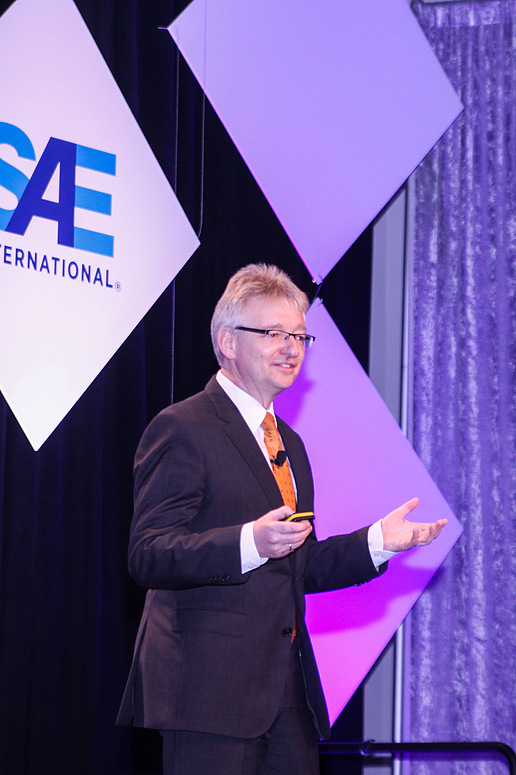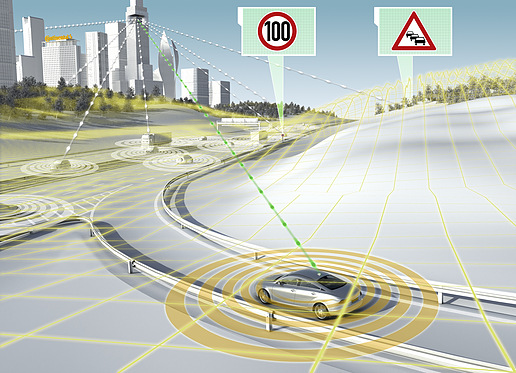 德国大陆集团执行董事Helmut Matschi在2015 SAE全球年会上发表主题演讲。
德国大陆集团执行董事Helmut Matschi在2015 SAE全球年会上发表主题演讲。 德国大陆集团新推出的eHorizon是一个与IBM、思科和Here公司共同开发的基于云平台的产品。
德国大陆集团新推出的eHorizon是一个与IBM、思科和Here公司共同开发的基于云平台的产品。
交通堵塞、交通事故和尾气排放问题,都是人们的心头大患,因此汽车行业面临的一大隐性挑战就是如何为全社会开发合适的技术,并加以应用。
数据表明,2013年洛杉矶的驾驶员平均在交通拥堵中所花费的时间为90小时。同年,美国因交通事故死亡的人数为3.3万人,而甚至连尾气排放都能导致死亡。
“这个数据让我很震惊:从全球来看,道路交通污染直接导致5.3了的万人死亡,大多数是尾气烟尘造成的,”大陆公司执行董事HelmutMatschi表示。“这个数字非常高,会让我们怀疑继续生产汽车是否还有意义?但答案显然是肯定的。”
在底特律科博会展中心的AVL剧场,也就是2015SAE全球年会的会场,Matschi是周二早上的主题演讲嘉宾。
汽车互联技术有助于降低事故率,减少交通拥堵,并降低排放。
“过去的汽车无法通过互联网相连,而今天,越来越多的汽车可以联网。未来的汽车将会成为万物互联网络(IoE)的一部分,” Matschi说。
大陆汽车集团电子地平线(eHorizon)战略的下一步计划,就是基于IoE概念进行研发。
目前所生产的eHorizon平台主要依赖于传感器和地图数据,于2012年首次推出。eHorizon的客户之一为商用卡车制造商Scania。使用其车辆的车队运营商通过使用这一产品,可以提早对下一段行驶路线中发生的变化做出调整。该系统的一个主要优势就是可以帮助用户降低燃油消耗。
“这个系统已经帮助我们节约了3%的燃油。借助(基于传感器的)静态eHorizon平台,我们至今已经节约了2300万加仑柴油,相当于实现了239吨二氧化碳的减排成果,” Matschi称。今年晚些时候,将会有另外4家重型卡车的OEM在其生产的车辆上使用大陆汽车的eHorizon。
大陆汽车新推出的Dynamic eHorizon是一个基于云平台的产品。大陆汽车与IBM、思科和位置云公司Here联手开发,将数字地图变成了一个高度精准、实时更新的信息载体。
“做到了这一点,我们就能在安全度、舒适度和排放这些方面实现很多提升,” Matschi表示。DynamiceHorizon还支持其他科技,包括驾驶员辅助系统、导航系统和增强现实平视显示器等。
但这些先进技术都会增加软件的复杂程度。
“软件的需求越来越高,” Matschi指出,一辆常见的豪华车可能装有160个以上传感器、多达100个ECU、以及170多个的执行器。“再加上未来车间互联的可能性,不同电子元件之间的信息通讯还将更加密切。”
通过行业合作,我们可以实现这一目标。
“如果我们能够像现在这一齐心协力,提升驾驶的舒适度和安全性,并减少二氧化碳排放,那么汽车还将会在未来的道路上继续行驶。” Matschi说。
作者:Kami Buchholz
来自:SAE Automotive Engineering Magazine
Continental's Matschi: mobility is changing
Traffic gridlock, accident fatalities, and vehicle emissions are not good things. So the underlying challenge for the auto industry is to develop and use technologies appropriately for society.
Data shows that in 2013, Los Angeles drivers spent 90 hours stuck in traffic. That same year there were 33,000 fatalities on U.S roads. Even vehicle emissions caused death.
“This was really for me a surprising (statistic): Globally, 53,000 fatalities were directly attributed to road traffic pollution, mostly because of exhaust fumes," said Helmut Matschi, Executive Board Member at Continental. "That’s a real high number. So that could lead to the question: Does it really make sense to work further on cars? But clearly for us the answer is yes.”
Matschi was the Thursday morning keynote speaker in the AVL theater inside Detroit’s Cobo Center at the 2015 SAE World Congress.
A connected vehicle could help reduce accidents, traffic congestion, and emissions.
“In the past, vehicles had no access to the Internet. Today, more and more vehicles have Internet access. Tomorrow, the vehicle will be part of the Internet of Everything (IoE),” according to Matschi.
The next evolution of Continental's electronic Horizon (eHorizon) strategy underscores the concept of IoE.
The current production version of eHorizon relies on sensors and map data. Launched in 2012, fleet operators using Scania commercial trucks can adjust to changes in an upcoming route early. A major benefit is reduced fuel consumption.
“This has already saved three percent of fuel. With that static (sensor-based) eHorizon, we have up to now saved 23 million gallons of diesel. When we convert this into CO2, that’s an equivalent of 239 tons,” said Matschi. Continental’s eHorizon will be used by four other heavy-duty truck OEMs later this year.
Continental’s new Dynamic eHorizon is cloud-based. In collaboration with IBM,Cisco, and the location cloud company Here, it turns the digital map into a highly precise and up-to-date information carrier.
“With that we can enhance a lot of activities on the safety side, on the comfort side, (and) emissions side,” said Matschi. Dynamic eHorizon also supports other technologies, including driver-assistance systems, navigation systems, and augmented-reality head-up displays.
All of these various advanced technologies add software complexity.
“The software demand is increasing and increasing,” said Matschi, noting that a typical luxury vehicle can have more than 160 sensors, up to 100 ECUs, and more than 170 actuators. “And with the possibility of connectivity there is even more interest that different electronics communicate with each other.”
Industry partnerships can bring it all together.
“In order to enhance the driving comfort, to have safer driving, and to reduce CO2, if we stick together as an industry--as we do--then we are ready for vehicles, which are always on for future mobility,” said Matschi.
等级
打分
- 2分
- 4分
- 6分
- 8分
- 10分
平均分
- 作者:Kami Buchholz
- 行业:汽车
- 主题:电气电子与航空电子
